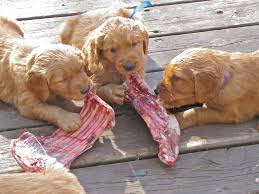 When you bring home a new puppy that was not raised on raw, it can be a bit trickier to get him started – although really not that difficult. There are just a few guidelines you need to follow to avoid digestive upset as your puppy transitions from kibble to raw food.
When you bring home a new puppy that was not raised on raw, it can be a bit trickier to get him started – although really not that difficult. There are just a few guidelines you need to follow to avoid digestive upset as your puppy transitions from kibble to raw food.
First, let’s address the issue that many people have with feeding large breed puppies raw. Yes, it is important to balance the calcium and phosphorus content in the food, but it’s easy to do with raw food – and in light of the dog foods that were recalled due to excesses of some nutrients, the ability to monitor the nutrients in raw food makes it a safer option than kibble in my opinion.
Here are a few tips for getting your puppy started on raw with a minimum of fuss – and minimal stains on your rugs!
- Start off cold turkey – or at least don’t mix with kibble It’s not wise to mix your puppy’s raw food with kibble. Because kibble requires a different pH in the gut to digest, it will make your puppy more susceptible to the bacteria in the raw meats. He is capable of handling this bacteria just fine, but once you add in artificial foods, the meat will sit in his digestive tract twice as long, meaning there is a much greater chance of harmful bacteria building up.
- Start with one protein source Regardless of whether you are preparing your own raw or are using a prepared raw food, it is best to start with just one protein source, like chicken or turkey. Give that one protein for a good week and, if there are no signs of digestive upset, start your puppy on a second source of protein, and so on.
- Balance the calcium and phosphorus This is fairly easy to do. If you view a turkey neck as a nice meaty bone, then your puppy’s diet should be half to two-thirds meaty bones and half to one-third meats and offal (organ meats). There is no magic formula and every puppy is a bit different. Despite what the kibble manufacturers say, it’s pretty easy to balance calcium and phosphorus and there is a wider margin of error when feeding raw. Calcium that comes in a synthetic powder is nearly impossible for a puppy to excrete, so excesses of calcium are more of a concern with synthetic products than with the naturally occurring calcium found in bones.
- Feed frequently Your puppy should eat three to four small meals a day until he is about six months of age – then he can eat twice a day and eventually once a day (larger breeds) if you wish. This is especially important for small breed puppies as they can become hypoglycemic if meals are spread out too long. Feeding large meals also stretches out the stomach, reducing its muscle tone.
- Feed 2-3% of his adult body weight* This is easier to determine if you have a purebred dog, but the amount you feed should be 2-3% of your puppy’s anticipated adult weight. If you’re not sure what that will be, then feed about 5-10% of his current weight. Watch to see if he gets too fat or too thin and adjust accordingly. See note below.
- Don’t overdo it with the offal Liver and other organ meat can cause some pretty nasty loose stools in puppies who have never had them before. If your puppy is new to raw feeding, wait until you see two or more weeks of solid stools before you introduce organ meats. Then add them in gradually instead of feeding one giant meal of liver. Don’t skip the organ meats; they are important because they are full of nutrients not found in muscle meat.
- Don’t forget the supplements Even if you’re feeding free range, organic meats, the earth is not what it used to be, so your puppy will benefit from some supplementation. Supplements to consider include:
- Fish oil (a source of Omega-3 fats – a good idea if the meat is not grass fed)
- Whole food vitamin-mineral complex (no synthetics)
- Coconut oil (antibacterial and antifungal)
- Nutritional herbs (alfalfa, dandelion leaf, nettle and more)
- Probiotics (soil-based products are best; green tripe is an excellent natural source of probiotics and digestive enzymes)
- Bovine colostrum (helps to build a strong immune system)
- Other important stuff Make sure your puppy has plenty of fresh, non-chlorinated water. He should also have plenty of fresh air and exercise. Exercise for young puppies should not be forced walks – his growing joints will suffer less stress if you take him outside for short play or training sessions instead. Keep the walks short – about five minutes per month of age until he is about six months of age. Thereafter, keep it under an hour for the first year.
- Find a mentor or raw feeding chat group You will find there are plenty of experienced dog owners who love to help. One day, you can return the favor and help another puppy owner realize how simple and beneficial it is to raise puppies on raw!
My Favorite Meaty bones (35% to 50% of the diet)
- Turkey tails and necks (wings for big dogs only)
- Chicken and duck backs, necks, and wings
- Lamb ribs
- Veal ribs and tails
- Venison bones of any kind
Muscle / Soft Tissue Meats (25% to 35% of the diet)
- From a variety of animals (includes heart and tongue)
- Offal (10% of the diet)
- Liver, kidneys, spleen, brain, lung
Vegetables (15% to 25% of the diet), Fruit, and Nuts / Seeds (0% to 10% of the diet)
- Aboveground and root vegetables: broccoli, cauliflower, dark leafy greens (spinach, kale, mustard greens, etc.), zucchini, carrots, peas, green beans, parsnips, turnips, cabbage, sprouts, etc. are all possibilities. Herbs are excellent but need to be in small amounts.
- Fruit and nuts: Best to feed fruits alone as they are digested quickly and tend to ferment when fed with a meal. Most nuts and seeds make excellent treats or additions to meals.
Balanced foods (feed often)
- Organic raw eggs with shell
- Green tripe
- Whole animals (rabbit, quail, etc.)
- Fish should be fed less often, due to mercury exposure
Extra Yummies
- Chicken feet and beef windpipes (good source of naturally occurring glucosamine and chondroitin)
- Beef neck or vertebrae bones (a great chew that won’t break teeth)
- Treats should have as few ingredients as possible and be all or mostly meat
*NOTE: Puppies are always hungry and may eat twice as much for their size as adults. Learn the growth habits of your breed and your puppy’s family if possible. Rely on observation as well and know that larger breeds mature more slowly than smaller breeds. The raw diet is balanced for all life stages, but quantities will vary for growing bodies. For puppies feed more food, as much as is needed to maintain healthy body condition. Healthy is when a waistline can be seen and the ribs can be easily felt (but not obvious to the eyes) when skimming the ribcage with your hands. Diet quantities are individual, and if your dog requires more or less to maintain an optimum weight as he grows, that is the amount you should be feeding. The daily amount should be divided and fed 3-4 times daily for puppies up to 6 months old, then 2 times daily thereafter or at least until fully mature.

Recent Comments